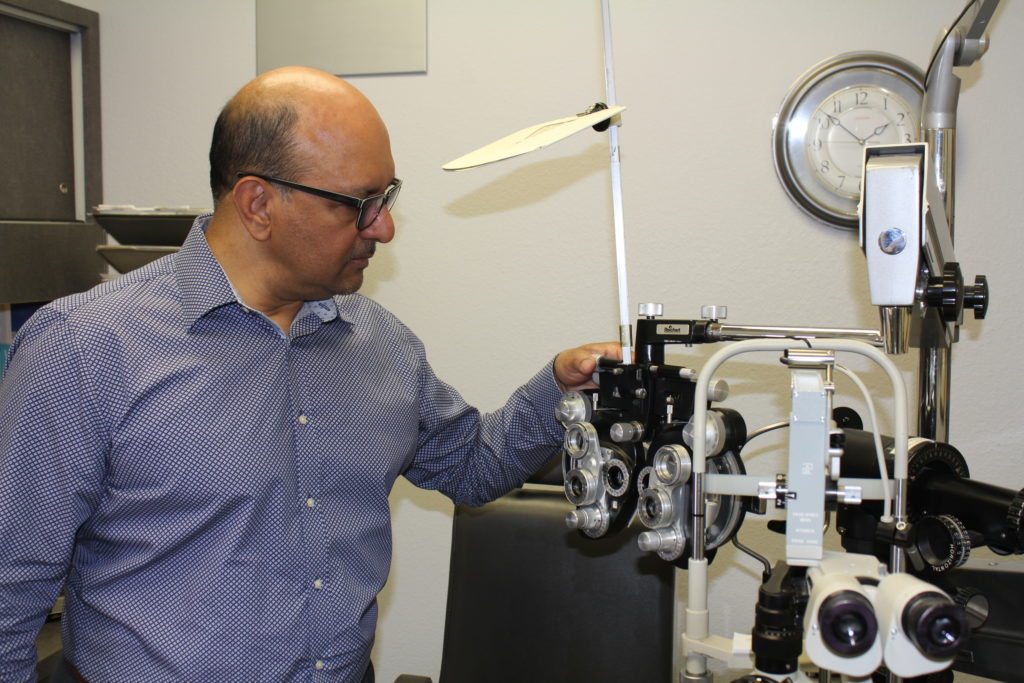
Make an appointment with an eye care professional if you notice problems with your close range vision. Photo: Site for Sore Eyes – Napa ©2020
After age 40, our eyes naturally begin to lose the ability to focus on near objects. The clinical term for this phenomenon is presbyopia, but the more common name is farsightedness. This condition can affect people who’ve never had problems with their vision before. With our growing reliance on smartphones and computers for our work and social lives, treating farsightedness is essential for daily comfort.
What Leads to Farsightedness?
Farsightedness is caused by the gradual thickening of the eye lens and a loss in lens flexibility that starts to happen after age 40. As the lens loses elasticity, the eye has a harder time focusing on close details, which makes reading an increasingly fraught activity.
Farsightedness is a natural part of the aging process, but if left untreated, it can lead to headaches, eye strain and fatigue. If you find yourself suffering from the symptoms of farsightedness, it’s important to have your eyes checked by a qualified eye care professional in your area.
Treatments for Farsightedness
There are many options for treating farsightedness. The one that’s right for you will depend on the severity of your condition, your budget and whether you’re also nearsighted.
Reading glasses
Individuals who wear contact lenses or who aren’t nearsighted may opt to treat their farsightedness with reading glasses. These glasses are only worn when doing activities that require close vision. Inexpensive reading glasses are available from many drugstores, which makes them a good option for those on a budget. However, store-bought glasses have the same lens strength for each eye, whereas most individuals have a stronger eye and a weaker eye. An optician can provide a precise prescription for your degree of farsightedness and offer more durable reading glasses than you would find off the shelf.
Bifocals and progressive lenses
Those who already wear glasses to treat nearsightedness will need to acquire multifocal lenses to treat both myopia and presbyopia. Bifocals were first popularized by Benjamin Franklin in the 18th century. These glasses contain lenses with two distinct powers: the upper lens corrects nearsightedness for distance viewing and the lower lens corrects for farsightedness, which enables the wearer to focus on close objects and reading. Bifocals are fitted by eye care professionals who take careful measurements to ensure the differing lenses align appropriately with the wearer’s line of vision.
Progressive lenses are more expensive than bifocals, but they offer several advantages for the wearer. First, instead of just two lens powers, they use multiple lens powers to allow for a smoother gradation between near and distance viewing. Second, progressive lenses don’t have the distinct lines found between lenses in bifocals, which makes them a more fashionable choice for many wearers.
Contact lenses for farsightedness
If you already wear contact lenses for nearsightedness, your eye doctor can prescribe multifocal contact lenses once you start experiencing nearsightedness as well. As with glasses, multifocal contact lenses come in bifocal and progressive varieties. Some contact lens wearers choose a monovision solution: they wear a contact lens for nearsightedness in one eye and a contact lens for farsightedness in the other eye. Multifocal contact lenses, and progressive contacts in particular, tend to be more costly than standard contact lenses due to their complex design and the additional fittings required to get the best results.
Surgical Options for Farsightedness
Beyond eyeglasses and contact lenses, there are also FDA-approved surgical options for treating presbyopia. Surgeries only correct one eye, so it’s recommended that those considering a procedure first try monovision correction with contact lenses to see if they’re comfortable using one eye for near vision and the other for distance.
Conductive keratoplasty, marketed as NearVision CK, is an option for patients who only suffer from farsightedness. A doctor uses a tiny probe that emits low-level radio frequency energy to change the curvature of certain parts of the cornea. The procedure uses local anesthetic and lasts only a few minutes. The treated eye will now be somewhat nearsighted, so patients must learn to adjust between eyes or get fitted for glasses to wear while doing tasks that require long-distance vision, such as driving.
Corneal inlays can improve near vision without compromising distance vision. A doctor uses a laser to create a small pocket in the cornea of the non-dominant eye. The inlay is then placed over the pocket and seals to the cornea. The procedure takes about 15 minutes to complete. As with NearVision CK, corneal inlay surgery has its best results with patients aged 40 to 60 who don’t have other vision problems. Though not approved by the FDA, corneal inlay surgery can be combined with LASIK to treat presbyopia and myopia at the same time. Another advantage to this procedure is it can be reversed if the patient is dissatisfied with the results.
